How do project owners use pull requests on Github?
Pull-based development as a distributed development model is a distinct way of collaborating in software development. In this model, the project’s main repository is not shared among potential contributors; instead, contributors fork (clone) the repository and make their changes independent of each other. In the pull-based model, the role of the integrator is crucial. The integrator must act as a guardian for the project’s quality while at the same time keeping several (often, more than ten) contributions “in-flight” by communicating modification requirements to the original contributors. Being a part of a development team, the integrator must facilitate consensus-reaching discussions and timely evaluation of the contributions. In Open Source Software (OSS) projects, the integrator is additionally taxed with enforcing an online discussion etiquette and ensuring the project’s longevity by on-boarding new contributors.
In Apr 2014, we run a survey among Github users trying to understand how integrators (also contributors; still analyzing the results) use pull requests and to discover what challenges they may face. We got 750 responses.
We found three large themes in how integrators use pull requests: code reviews, soliciting contributions from the community and discussing new features. We also found that integrators are struggling with maintaining quality and prioritizing work, while social challenges do not allow them to be efficient.
How do integrators use pull requests in their projects?
Overall use
Overwhelmingly, 80% of the integrators use the pull-based development model for doing code reviews and 80% resolve issues. Half of the integrators use pull requests to discuss new features. 60% of the integrators use pull requests to solicit contributions from the community, which seems low given the open nature of the GitHub platform. We examined this response quantitatively, using the GHTorrent database: indeed for 39% percent of the projects that responded, no pull request originated from the project community.
Types of contributions
When discussing software maintenance, we distinguish perfective (implementing new features), corrective (fixing issues) and adaptive-preventive (refactoring) maintenance. We asked integrators how often they receive contributions for these types of maintenance activities. 73% percent of the projects receive bug fixes as pull requests once a week, half of them receive new features once a week, while only 33% of them receive a refactoring more often than once a week.
Code reviews
75% of the projects indicate that they do explicit code reviews on all contributions on Github. Interestingly, 7% of of the integrators indicated that they are using other tools for code reviewing.
50% of the integrators report that the project’s community (people with no direct commit access to the repository) actively participates in code reviews; this number is impressive and indicates very vibrant communities caring about projects.
Projects have established processes for doing code reviews. One of them is delegation; 42% of the integrators delegate a code review if they are not familiar with the code under review. Another process is implicit sign-off: at least 20 integrators reported that multiple developers are required to review a pull request to ensure high quality.
Integrating changes
In 79% of the cases, integrators use the GitHub web interface “often or always” to do a merge. Only in 8% and 1% of the cases do integrators resort to cherry picking or textual patches respectively to do the merge. The remaining cases do rebasing to maintain clean project history instead of simple merges.
summary: Integrators successfully use the pull-based model to accommodate code reviews, discuss new features and solicit external contributions. 75% of the integrators conduct explicit code reviews on all contributions. Integrators prefer commit metadata preserving merges.
How do integrators decide whether to accept a contribution?
Decision to accept
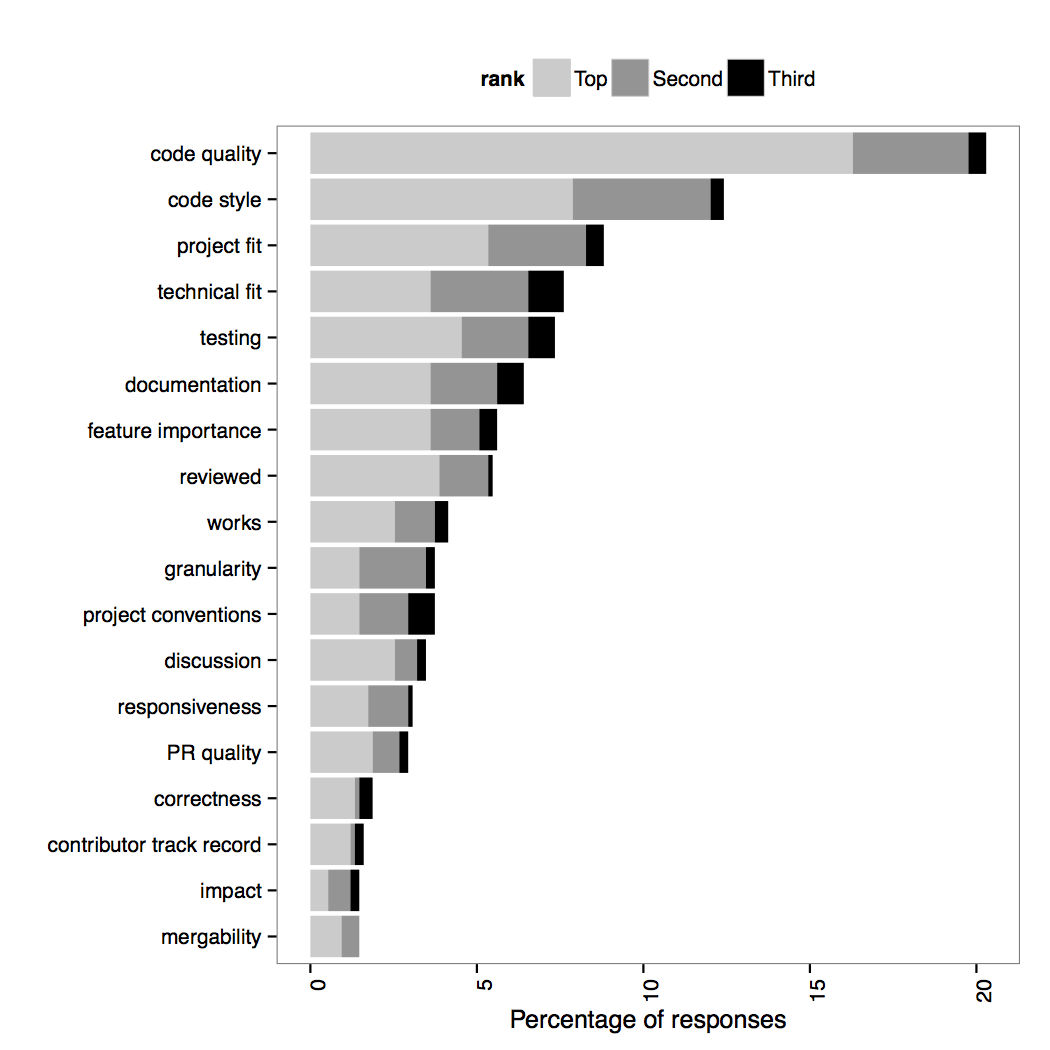
The most important factor leading to acceptance of a contribution is its quality. Quality has many manifestations in our response set; integrators examine the source code quality and code style of incoming code, along with its documentation and granularity. At a higher level, they also examine the quality of the commit set and whether it adheres to the project conventions for submitting pull requests.
A second signal that the integrators examine is project fit: does the pull request fit the project roadmap? A variation is technical fit: does the code fit the technical design of the project?
It is interesting to note that the track record of the contributors is ranked low in the integrator check list. This is in line with our earlier analysis of pull requests, in which we did not see a difference in treatment of pull requests from the core team or from the project’s community.
Finally, technical factors such as whether the contribution is in a mergeable state, its impact on the source code or its correctness are not very important for the eventual decision to merge to the majority of respondents. In such cases, integrators can simply postpone decisions until fixes are being provided by the contributors.
Time to make the acceptance decision
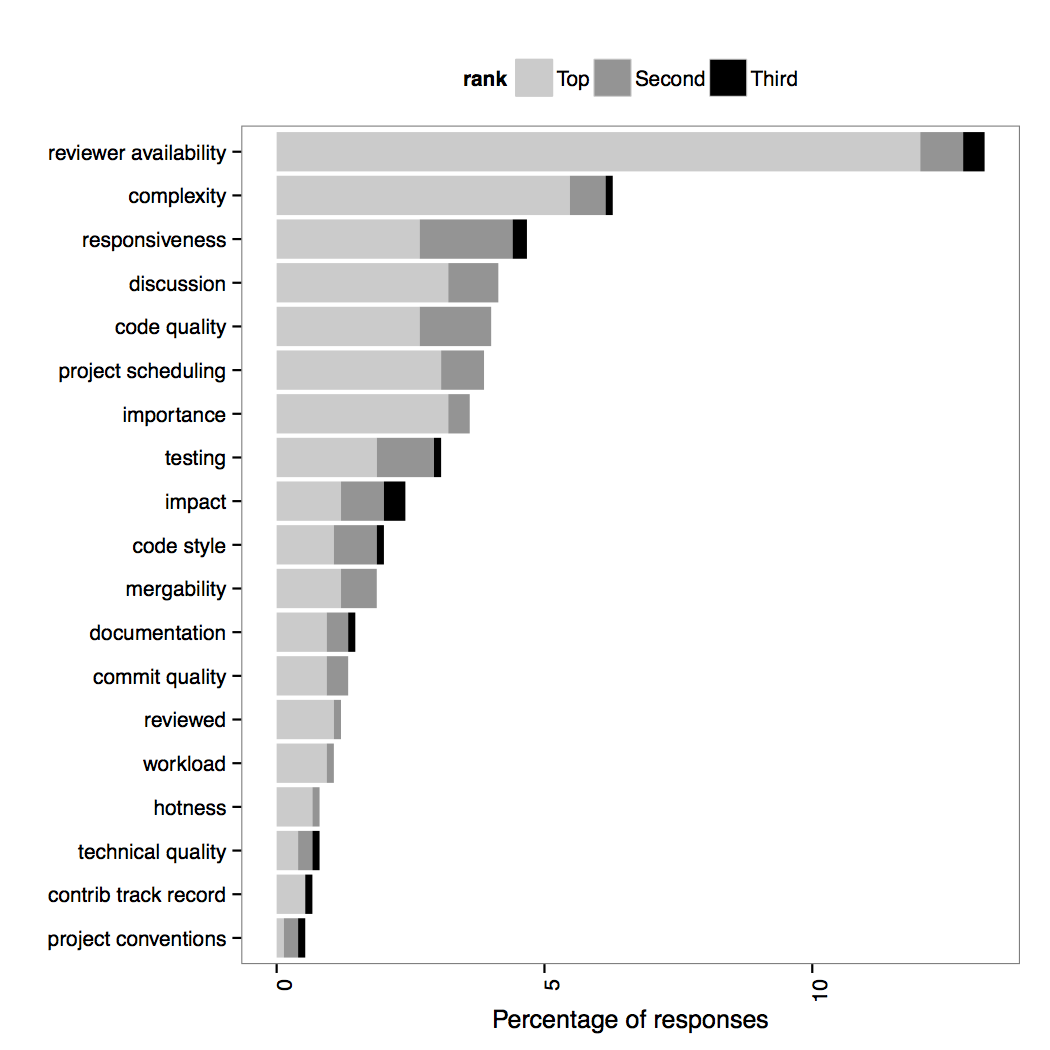
The factors that strongly affect the time to make a decision are mostly social and, as expected, have timing characteristics as well. The most important one, affecting 14% of the projects, is reviewer availability. The problem is more pronounced in projects with small integrator teams (45%) and no full time paid developers. Another social factor is contributor responsiveness; if the pull request contributor does not come back to requests for action fast, the evaluation process is stalled. Long discussions also affect negatively the time to decide, but they are required for reaching consensus among core team members, especially in case of controversial contributions. For changes that have not been communicated before, discussions are also mandatory.
Technical factors, such as the complexity of the change, code quality, code style and mergeability of the code also affect negatively the time to decide on a pull request. The reason is that the code inspection reveals issues that need to be addressed by the contributors.
summary: Integrators decide to accept a contribution based on its quality and its degree of fit to the project’s roadmap and technical design.
How do the integrators evaluate the quality of contributions?
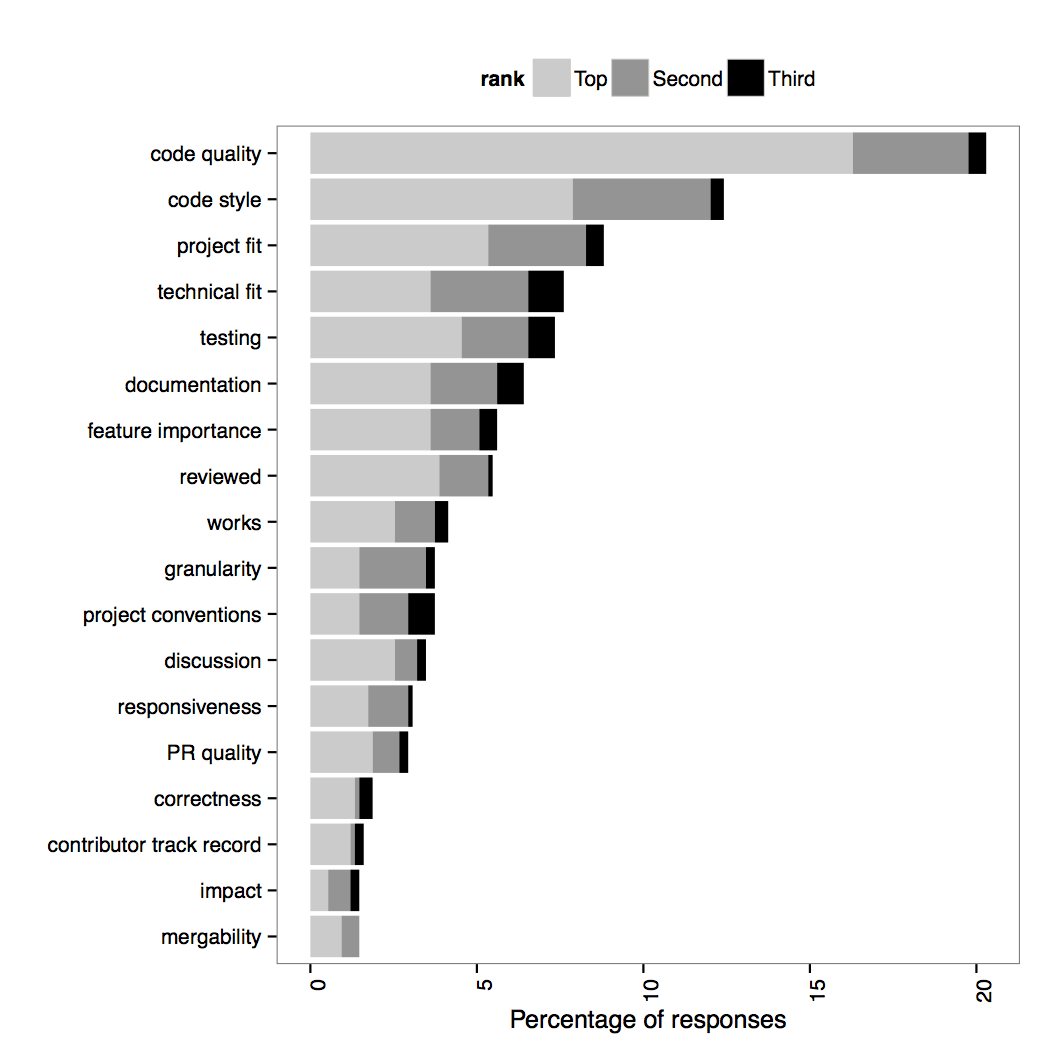
Perception
One of the top priorities for integrators when evaluating pull request quality is conformance. Conformance can mean conformance to project style or to API usage throughout the project. Many integrators also examine conformance against the programming language’s style idioms.
Integrators often relate contribution quality to the quality of the source code it contains. To evaluate source code quality, they mostly examine non-functional characteristics of the changes. Source code that is understandable and elegant, has good documentation and provides clear added value to the project with minimal impact is preferred.
The quality (or even the existence) of documentation signifies an increased attention to detail by the submitter. The integrators also examine the commit organization in the pull request along with its size. In the later case, the integrators value small pull requests as it is easier to assess their impact.
Testing plays an important role in evaluating submissions. The very existence of tests in the pull request is perceived as a positive signal.
Finally, integrators use social signals to build trust for the examined contribution. The most important one is the contributor’s reputation. The integrators build a mental profile for the contributor by evaluating their track record within the project or by searching information about the contributor’s work in other projects. Some integrators also use interpersonal relationships to make judgements for the contributor and, by proxy, for their work.
####Tools
The vast majority (75%) of projects use continuous integration, either in hosted services or in standalone setups. On the other hand, few projects use more dedicated software quality tools such as metric calculators (15%) or coverage reports (18%). It is interesting to note that practically all (98%) projects that use more advanced quality tools, run them through continuous integration.
summary: Top priorities for integrators when evaluating contribution quality include conformance to project style and architecture, source code quality and test coverage. Integrators use few quality evaluation tools other than continuous integration.
How do the integrators prioritize the application of contributions?
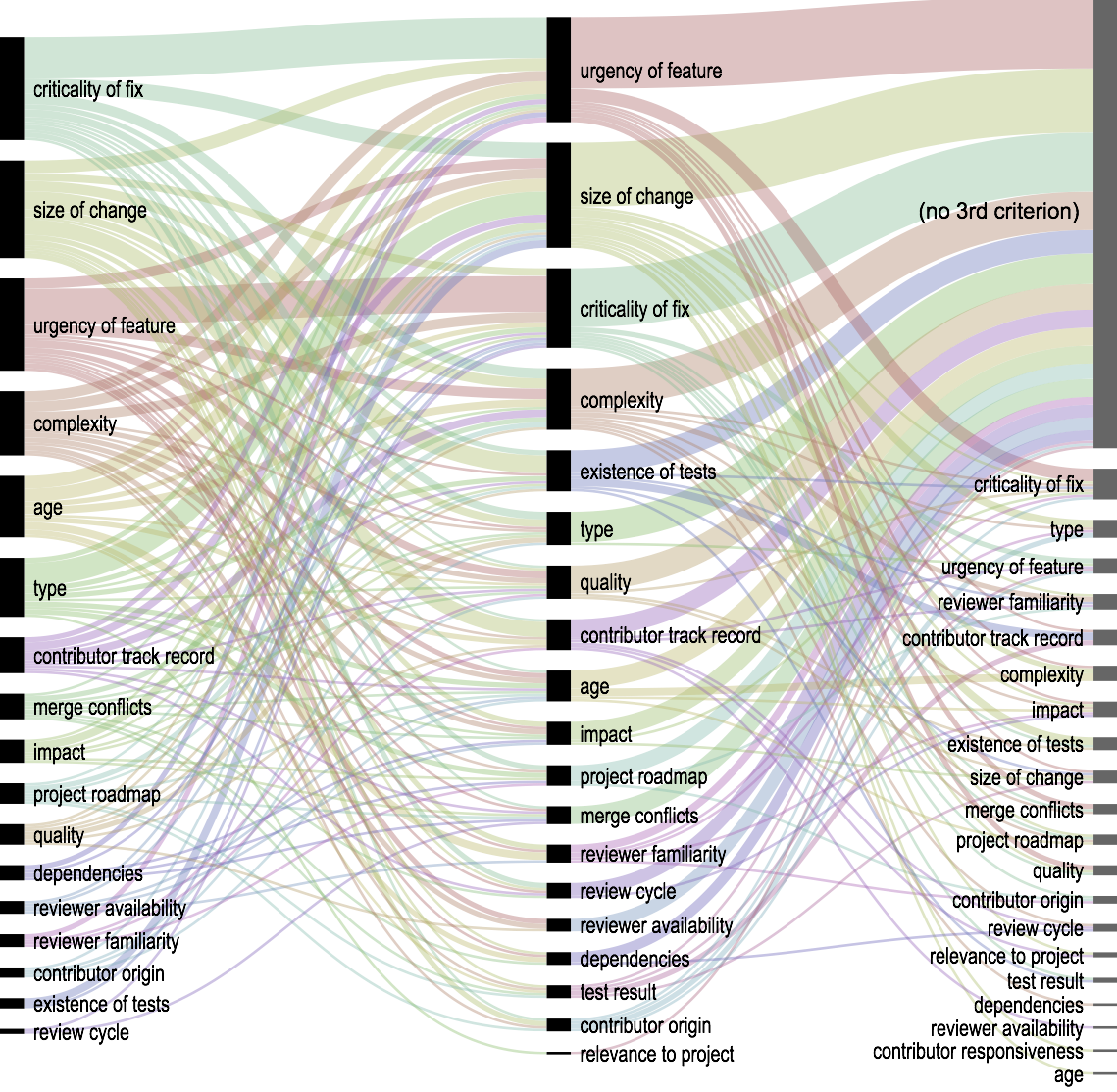
Integrators prioritize contributions by examining their criticality (in case of bug fixes), their urgency (in case of new features) and their size or complexity. Bug fixes are commonly given higher priority. When prioritizing contributions, integrators apply multiple criteria in a specific sequence. The figure above depicts the frequencies of prioritization criteria usage for all reported application sequences. What we can see is that criticality, urgency and change size contribute to most prioritization criteria application sequences, while most integrators report that they apply at most two prioritization criteria.
What key challenges do integrators face when working with pull requests?
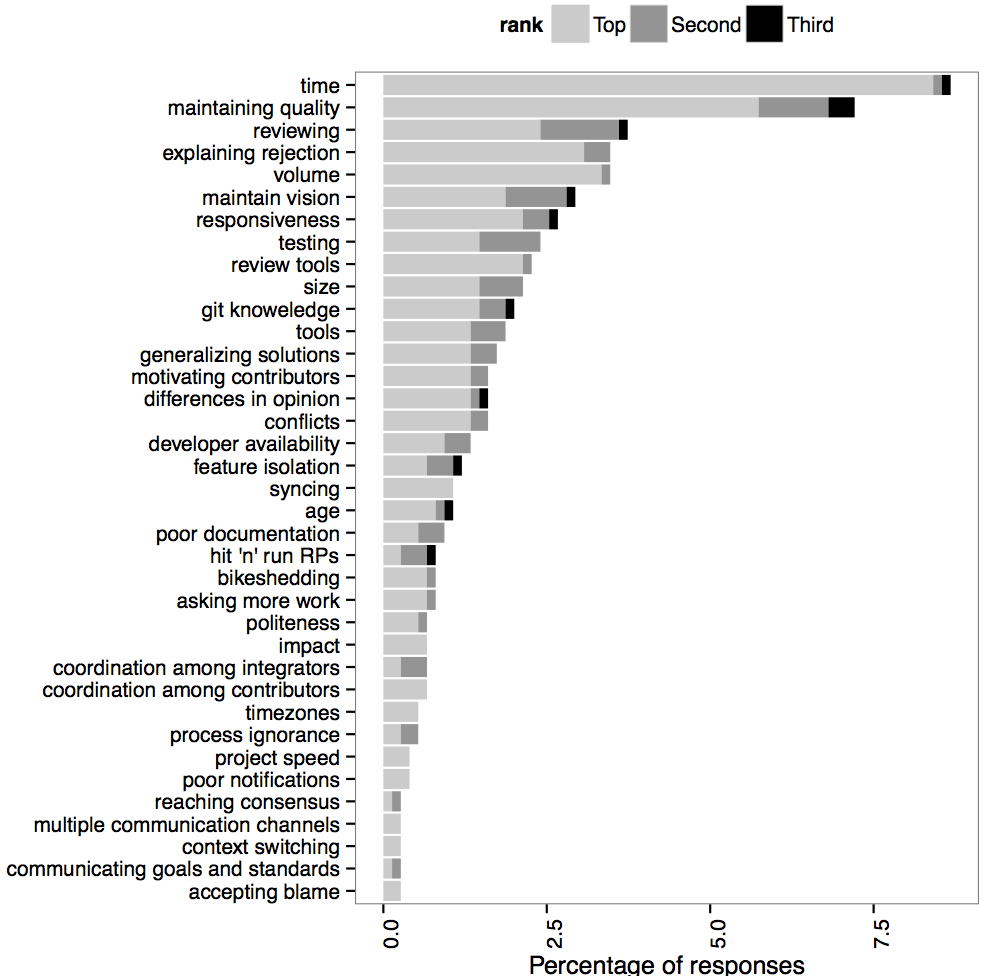
####Technical challenges
At the project level, maintaining quality is what most integrators perceive as a serious challenge. As incoming code contributions mostly originate from non-trusted sources, adequate reviewing may be required by integrators familiar with the project area affected by it. Reviewer availability is not guaranteed, especially in projects with no funded developers. Often, integrators have to deal with solutions tuned to a particular contributor requirement or an edge case; asking the contributor to generalize them to fit the project goals is not straightforward. A related issue is feature isolation; contributors submit pull requests that contain multiple features and affect multiple areas of the project.
Several issues are aggravated the bigger or more popular a project is. Integrators of popular projects mentioned that the volume of incoming contributions is just too big; consequently, they see triaging and work prioritization as challenges. Additionally, as pull requests are kept on the project queue, they age: the project moves ahead in terms of functionality or architecture and then it is difficult to merge them without (real or logical) conflicts. Moreover, it is not straightforward to assess the impact of stale pull requests on the current state of the project or on each other.
Integrators note that aspiring contributors often ignore the project processes for submitting pull requests leading to unnecessary communication rounds. When less experienced developers or regular users attempt to submit a pull request, they often lack basic git skills.
Lack of responsiveness on behalf of the contributor hurts the code review process and, by extension, project flow. This especially pronounced in the case of hit and run pull requests,5 as they place additional reviewing and implementation burden on the integrator team. Integrators mention that the lack of centralized co-ordination with respect to project goals can lead to chaos.
####Social challenges
On a more personal level, integrators find it difficult to handle the workload imposed by the open submission process afforded by the pull-based development model. For many of our respondents, managing contributions is not their main job; consequently finding free time to devote on handling a pull request and context switching between various tasks puts a burden on integrators.
Integrators often have to make decisions that affect the social dynamics of the project. Integrators reported that explaining the reasons for rejection is one of the most challenging parts of their job as hurting the contributor’s feelings is something they seek to avoid. Similarly, integrators find that asking for more work from the contributors (e.g. as a result of a code review) can be difficult at times.
Reaching consensus through the pull request comment mechanism can be challenging. Integrators often find themselves involved in a balancing act of trying to maintainting their own vision of the project’s future and incorporating (or rejecting) contributions that are tuned to the contributor’s needs.
summary: Integrators are struggling to maintain quality and mention feature isolation and total volume as key technical challenges. Social challenges include motivating contrib- utors to keep working on the project, reaching consensus through the pull request mechanism and explaining reasons for rejection without discouraging contributors.
So what?
This study is one of the first to investigate how people use pull requests and definitely the first to do it on this scale. It answered our questions, but it generated more; we present some of them below. Researchers and aspiring entrepreneurs are welcome to answer them by doing further research and/or by developing new tools.
- How can we facilitate the quality evaluation process involved in pull requests?
- How can we help integrators in large projects cope with the load of incoming pull requests?
- How can we raise the awareness of newcomers wrt what is happening in the project? How can we avoid duplicate work?
- What can projects or the Github platform do to streamline their contribution process?
Some advice:
-
Integrators, invest in tools: Streamline your contribution process to make it testable and verifiable, find creative ways to integrate quality analysis tools in your CI process and demand tests along with contributions (your test suite is good, right?). Don’t let pull requests linger; if you don’t want a contribution it is better (for you, mostly) to be frank to the contributor.
-
Contributors, make sure you do your homework: see if there are similar issues/pull requests open before you submit, try to comply to the project’s guidelines and learn your tools. After submitting, be responsive and nice; think that you are working together with a work-overloaded collegue, not a stranger in the other side of the world.
Last but not least, I would like to thank the participants for their time: this research would not be possible if 750 people would not have each donated 15 minutes each (187 total hours!).
What do you think of the results? Do they reflect your personal experience? What tools would you expect us researchers to provide you with to cope with pull requests? Chime in below!
*This blog post is a brief account of our findings. An in-depth analysis, including a description of our analysis methods and the original survey can be found in our technical report. This is joint work with Andy Zaidman, Margaret-Anne Storey and Arie van Deursen. *
If you liked this post, you will also like our previous work on how projects use pull requests.
Update 20/12/2014: The paper has been accepted at ICSE 2015!